Methodology and Application of Statistical Techniques to Evaluate the Reliability of Electrical Systems Based on the Use of High Variability Generation Sources
Abstract
:1. Introduction
2. Methodology
2.1. Statistical Analysis of the Electricity Balance
2.2. Monte-Carlo Optimization of the Electricity Balance
3. Results and Discussion
3.1. Statistical Approach
3.1.1. Data Analysis
3.1.2. Daily Averaged Approach
3.1.3. Monte-Carlo Approach
3.2. Additional Strategies Based on Nuclear Energy and Electricity Storage
3.3. Dependency between Scenarios and Energy Wastages
4. Conclusions
Author Contributions
Funding
Institutional Review Board Statement
Informed Consent Statement
Conflicts of Interest
References
- International Energy Agency, 2018. World Energy Outlook 2018. Summary Executive. Available online: https://webstore.iea.org/download/summary/190?fileName=English-WEO-2018-ES.pdf (accessed on 11 February 2019).
- British Petroleum, 2019. BP Energy Outlook 2019. British Petroleum. Available online: https://www.bp.com/content/dam/bp/business-sites/en/global/corporate/pdfs/energy-economics/energy-outlook/bp-energy-outlook-2019.pdf (accessed on 3 February 2021).
- Whiting, K.; Carmona, L.G.; Sousa, T. A review of the use of exergy to evaluate the sustainability of fossil fuels and non-fuel mineral depletion. Renew. Sust. Energ. Rev 2017, 76, 202–211. [Google Scholar] [CrossRef]
- IPCC. Renewable Energy Sources and Climate Change Mitigation: Special Report of the Intergovernmental Panel on Climate Change; Cambridge University Press: Cambridge, UK, 2012; ISBN 978-1-107-60710-1. [Google Scholar]
- PBL Netherlands Environmental Assessment Agency. 2017. Growth in Global Greenhouse Gas Emissions Resumed in 2017. Available online: https://www.pbl.nl/en/news/newsitems/2018/growth-in-global-greenhouse-gas-emissions-resumed-in-2017 (accessed on 28 January 2021).
- Jiang, X.; Guan, D. Determinants of global CO2 emissions growth. Appl. Energy 2016, 184, 1132–1141. [Google Scholar] [CrossRef] [Green Version]
- Henriques, S.T.; Borowiecki, K.J. The drivers of long-run CO2 emissions in Europe, North America and Japan since 1800. Energy Policy 2017, 101, 537–549. [Google Scholar] [CrossRef]
- Zhao, W.; Cao, Y.; Miao, B.; Wang, K.; Wei, Y.-M. Impacts of shifting China’s final energy consumption to electricity on CO2 emission reduction. Energy Econ. 2018, 71, 359–369. [Google Scholar] [CrossRef]
- European Commission. Strategic Energy Technology (SET) Plan; European Commission: Luxembourg, 2017; ISBN 978-92-79-74277-4. [Google Scholar]
- Zaman, K.; Moemen, M.A. Energy consumption, carbon dioxide emissions and economic development: Evaluating alternative and plausible environmental hypothesis for sustainable growth. Renew. Sust. Energ. Rev. 2017, 74, 1119–1130. [Google Scholar] [CrossRef]
- Sun, X.; Zhang, B.; Tang, X.; McLellan, B.C.; Höök, M. Sustainable energy transitions in China: Renewable options and impacts on the electricity system. Energies 2016, 9, 980. [Google Scholar] [CrossRef] [Green Version]
- De Llano Paz, F.; Calvo-Silvosa, A.; Iglesias Antelo, S.; Soares, I. The European low-carbon mix for 2030: The role of renewable energy sources in an environmentally and socially efficient approach. Renew. Sust. Energ. Rev. 2015, 48, 49–61. [Google Scholar] [CrossRef]
- Cirstea, S.; Cirstea, A.; Steluta Martis, C.; Fülöp, T.M. Current situation and future perspectives of the romanian renewable energy. Energies 2018, 11, 3289. [Google Scholar] [CrossRef] [Green Version]
- Huber, M.; Dimkova, D.; Hamacher, T. Integration of wind and solar power in Europe: Assessment of flexibility requirements. Energy 2014, 69, 236–246. [Google Scholar] [CrossRef] [Green Version]
- Belderbos, A.; Delarue, E. Accounting for flexibility in power system planning with renewables. Int. J. Electr. Power Energy Syst. 2015, 71, 33–41. [Google Scholar] [CrossRef] [Green Version]
- Ndawula, M.B.; Djokic, S.Z.; Hernando-Gil, I. Reliability enhancement in power networks under uncertainty from distributed energy resources. Energies 2019, 12, 531. [Google Scholar] [CrossRef] [Green Version]
- Hong, S.; Bradshaw, C.J.A.; Brook, B.W. Global zero-carbon energy pathways using viable mixes of nuclear and renewables. Appl. Energy 2015, 143, 451–459. [Google Scholar] [CrossRef]
- Cany, C.; Mansilla, C.; Mathonnière, G.; da Costa, P. Nuclear contribution to the penetration of variable renewable energy sources in a French decarbonized power mix. Energy 2018, 150, 544–555. [Google Scholar] [CrossRef]
- Suman, S. Hybrid nuclear-renewable energy systems: A review. J. Clean. Prod. 2018, 181, 166–177. [Google Scholar] [CrossRef]
- Mohamad, F.; Teh, J.; Lai, C.-M.; Chen, L.-R. Development of energy storage systems for power network reliability: A review. Energies 2018, 11, 2278. [Google Scholar] [CrossRef] [Green Version]
- Lazkano, I.; Nφstbakken, L.; Pelli, M. From fossil fuels to renewables: The role of electricity storage. Eur. Econ. Rev. 2017, 99, 113–129. [Google Scholar] [CrossRef] [Green Version]
- McPherson, M.; Johnson, N.; Strubegger, M. The role of electricity storage and hydrogen technologies in enabling global low-carbon energy transitions. Appl. Energy 2018, 216, 649–661. [Google Scholar] [CrossRef]
- Kharel, S.; Shabani, B. Hydrogen as a long-term large-scale energy storage solution to support renewables. Energies 2018, 11, 2825. [Google Scholar] [CrossRef] [Green Version]
- Bhattacharyya, S.C.; Timilsina, G.R. A review of energy system models. Int. J. Energy Sect. Manag. 2010, 4, 494–518. [Google Scholar] [CrossRef]
- Amorim, F.; Pina, A.; Gerbelová, H.; da Silva Pereira, P.; Vasconcelos, J.; Martins, V. Electricity decarbonisation pathways for 2050 in Portugal: A TIMES (The Integrated MARKAL-EFOM System) based approach in closed versus open systems modelling. Energy 2014, 69, 104–112. [Google Scholar] [CrossRef] [Green Version]
- Lund, H.; Østergaard, P.A.; Connolly, D.; Mathiesen, B.V. Smart energy and smart energy systems. Energy 2017, 137, 556–565. [Google Scholar] [CrossRef]
- Splitter, N.; Gladkikh, G.; Diemer, A.; Davidsdottir, B. Understanding the current energy paradigm and energy system models for more sustainable energy system development. Energies 2019, 12, 1584. [Google Scholar] [CrossRef] [Green Version]
- Ringkφb, H.-K.; Haugan, P.M.; Solbrekke, I.M. A review of modelling tols for energy and electricity systems with large shares of variable renewables. Renew. Sustain. Energy Rev. 2018, 96, 440–459. [Google Scholar]
- Lopion, P.; Markewitz, P.; Robinius, M.; Stolten, D. A review of current challenges and trends in energy systems modeling. Renew. Sustain. Energy Rev. 2018, 96, 156–166. [Google Scholar] [CrossRef]
- Yue, X.; Pye, S.; DeCarolis, J.; Li, F.G.N.; Rogan, F.; Gallachóir, B.Ó. A review of approaches to uncertainty assessment in energy system optimization models. Energy Strategy Rev. 2018, 21, 204–217. [Google Scholar] [CrossRef]
- Hall, L.M.H.; Buckley, A.R. A review of energy systems models in the UK: Prevalent usage and categorisation. Appl. Energy 2016, 169, 607–628. [Google Scholar] [CrossRef] [Green Version]
- Collins, S.; Deane, J.P.; Ponceletd, K.; Panos, E.; Pietzcker, R.C.; Delarued, E.; Pádraig Ó Gallachóir, B. Integrating short term variations of the power system into integrated energy system models: A methodological review. Renew. Sustain. Energy Rev. 2017, 76, 839–856. [Google Scholar] [CrossRef] [Green Version]
- Das, A.; Halder, A.; Mazumder, R.; Kumar, V.; Parikh, J.; Parikh, K.S. Bangladesh power supply scenarios on renewables and electricity import. Energy 2018, 155, 651–667. [Google Scholar] [CrossRef]
- Mirjat, N.H.; Uqaili, M.A.; Harijan, K.; Das Walasai, G.; Mondal, A.H.; Sahin, H. Long-term electricity demand forecast and supply side scenarios for Pakistan (2015e2050): A LEAP model application for policy analysis. Energy 2018, 165, 512–526. [Google Scholar] [CrossRef]
- Loulou, R.; Goldstein, G.; Noble, K. Documentation for the MARKAL Family of Models. 2004. Available online: http://www.etsap.org/tools.htm (accessed on 18 February 2019).
- Loulou, R.; Remne, U.; Kanudia, A.; Lehtila, A.; Goldstein, G. Documentation for the TIMES Model: Part III; IEA Energy Technology Systems Analysis Programme (ETSAP). 2016. Available online: http://www.ieaetsap.org/web/Documentation.asp (accessed on 18 February 2019).
- Heaton, C. Modelling Low-carbon Energy System Designs with the ETI ESME Model; Energy Technologies Institute: Loughborough, UK, 2014. [Google Scholar]
- Messner, S.; Strubegger, M. User’s Guide for MESSAGE III; IIASA: Laxenburg, Austria, 1995. [Google Scholar]
- Capros, P.; van Regemorter, D.; Paroussos, L.; Karkatsoulis, P.; Fragkiadakis, C.; Tsani, S. GEM-E3 Model Documentation; Publications Office of the European Union: Luxembourg, 2013. [Google Scholar]
- Energy and Power Evaluation Program. (ENPEP-BALANCE)—Brief Model Overview—Version 2.25; Argonne: Argonne National Laboratory, Center for Energy, Environmental, and Economic Systems Analysis (CEEESA): Lemont, IL, USA, 2008. [Google Scholar]
- EIA. Assumptions to the Annual Energy Outlook 2017; EIA: Paris, France, 2017. [Google Scholar]
- Strachan, N.; Kannan, R. Hybrid modelling of long-term carbon reduction scenarios for the UK. Energy Econ. 2008, 30, 2947–2963. [Google Scholar] [CrossRef]
- Messner, S.; Schrattenholzer, L. MESSAGE-MACRO: Linking an energy supply model with a macroeconomic module and solving it iteratively. Energy 2000, 25, 267–282. [Google Scholar] [CrossRef] [Green Version]
- SEI. LEAP: Low Emissions Analysis Platform. 2008. Available online: sei.org (accessed on 2 September 2021).
- Stehfest, E.; van Vuuren, D.; Bouwman, L.; Kram, T. Integrated Assessment of Global Environmental Change with IMAGE 3.0: Model Description and Policy Applications; Netherlands Environmental Assessment Agency (PBL): The Hauge, Netherlands, 2014; ISBN 978-94-91506-71-0. [Google Scholar]
- Klein, D.; Mouratiadou, I.; Pietzcker, R.; Piontek, F.; Roming, N. Description of the REMIND Model; Potsdam Institute for Climate Impact Research: Potsdam, Germany, 2017. [Google Scholar]
- Hunter, K.; Sreepathi, S.; DeCarolis, J. F Modeling for insight using tools for energy model optimization and analysis (Temoa). Energy Econ. 2013, 40, 339–349. [Google Scholar] [CrossRef]
- Scholz, Y.; Gils, H.C.; Pietzcker, R. Application of a high-detail energy system model to derive power sector characteristics at high wind and solar shares. Energy Econ. 2016, 64, 568–582. [Google Scholar] [CrossRef] [Green Version]
- ETSAP. ETSAP-TIAM Download. 2016. Available online: iea-etsap.org (accessed on 2 September 2021).
- UCL. 2016. Available online: https://www.ucl.ac.uk/energy-models/models/tiam-ucl/#etsap-tiam (accessed on 2 September 2021).
- Bosetti, V.; Massetti, E.; Tavoni, M. The WITCH model: Structure, Baseline, Solutions; FEEM Working paper No. 10.2007 and CMCC Research Paper Series No. 07; FEEM: Milano, Italy, 2007. [Google Scholar]
- Mordechai, S. Applications of Monte Carlo Method in Science and Engineering; IntechOpen Limited: London, UK, 2011; ISBN 978-953-307-691-1. [Google Scholar]
- Estrategia Energética Española a Medio y Largo Plazo; Club Español de la Energía: Madrid, Spain, 2015.
- International Energy Agency. Projections: Energy Policies of IEA Countries. 2017. Available online: http://www.iea.org/statistics/topics/energybalances/ (accessed on 24 February 2021).
- International Energy Agency. 2018. Available online: https://www.iea.org/statistics/?country=SPAIN&year=2016&category=Energy%20supply&indicator=TPESbySource&mode=table&dataTable=BALANCES (accessed on 1 February 2021).
- Graabak, I.; Korpas, M. Variability characteristics of european wind and solar power resources—A review. Energies 2016, 9, 449. [Google Scholar] [CrossRef] [Green Version]
- Wilk, S.S. Determination of sample sizes for setting tolerance limits. Ann. Math. Stat. 1941, 12, 91–96. [Google Scholar] [CrossRef]
- Glaeser, H. GRS method for uncertainty and sensitivity evaluation of code results and applications. Sci. Technol. Nucl. Install. Vol. 2008, Article ID 798901, 1–7. [Google Scholar] [CrossRef] [Green Version]
- Guba, A.; Makai, M.; Pál, L. Statistical aspects of best estimate method—I. Reliab. Eng. Syst. Saf. 2003, 80, 217–232. [Google Scholar] [CrossRef]
- Nutt, W.T.; Wallis, G.B. Evaluation of nuclear safety from the outputs of computer codes in the presence of uncertainties. Reliab. Eng. Syst. Saf. 2004, 83, 57–77. [Google Scholar]
- Red Eléctrica de España (REE), Sistema de Información del Operador del Sistema (ESIOS). Available online: ttps://www.esios.ree.es/es (accessed on 1 February 2021).
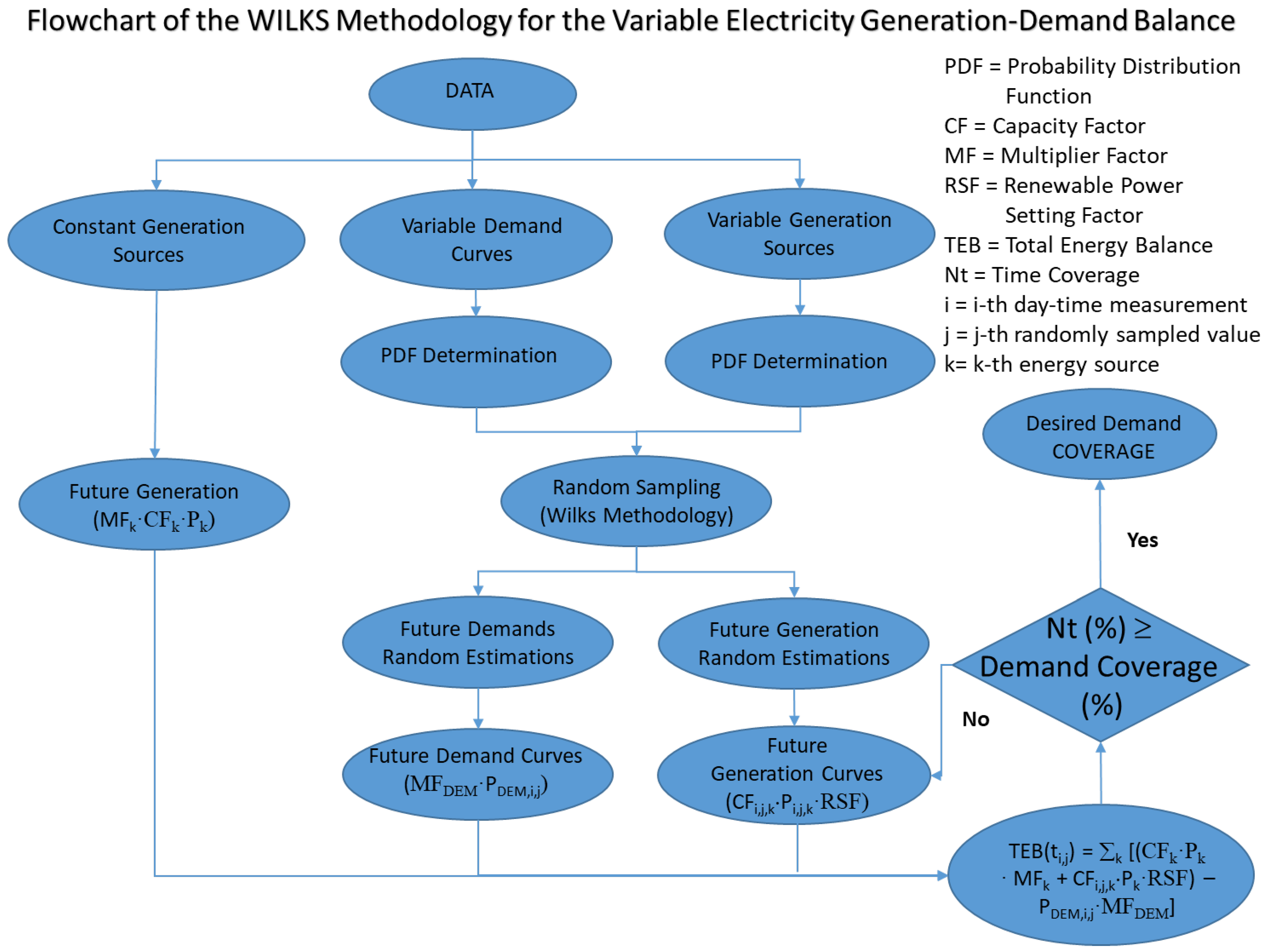

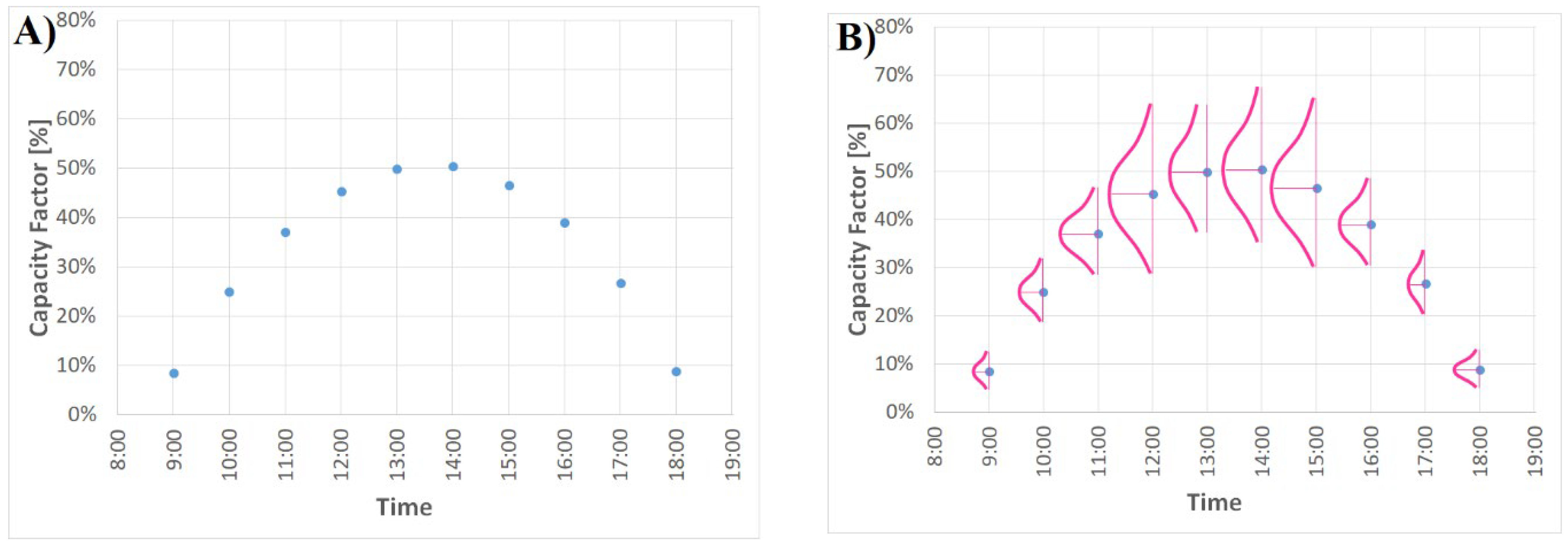
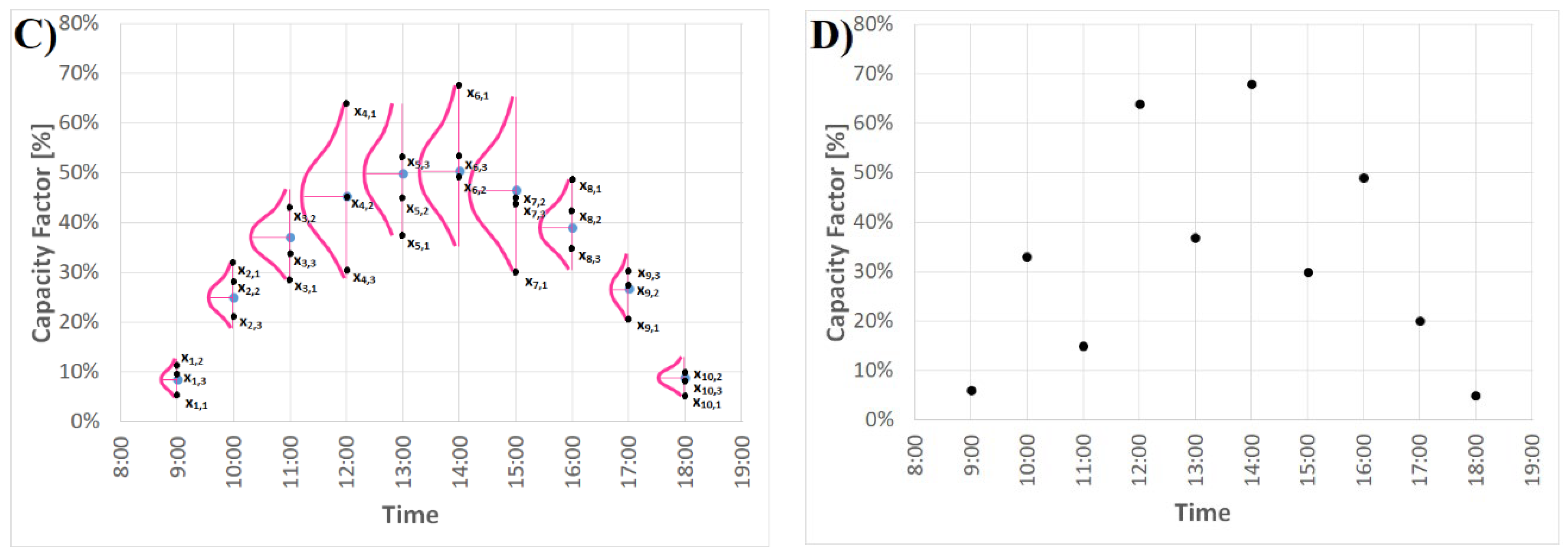

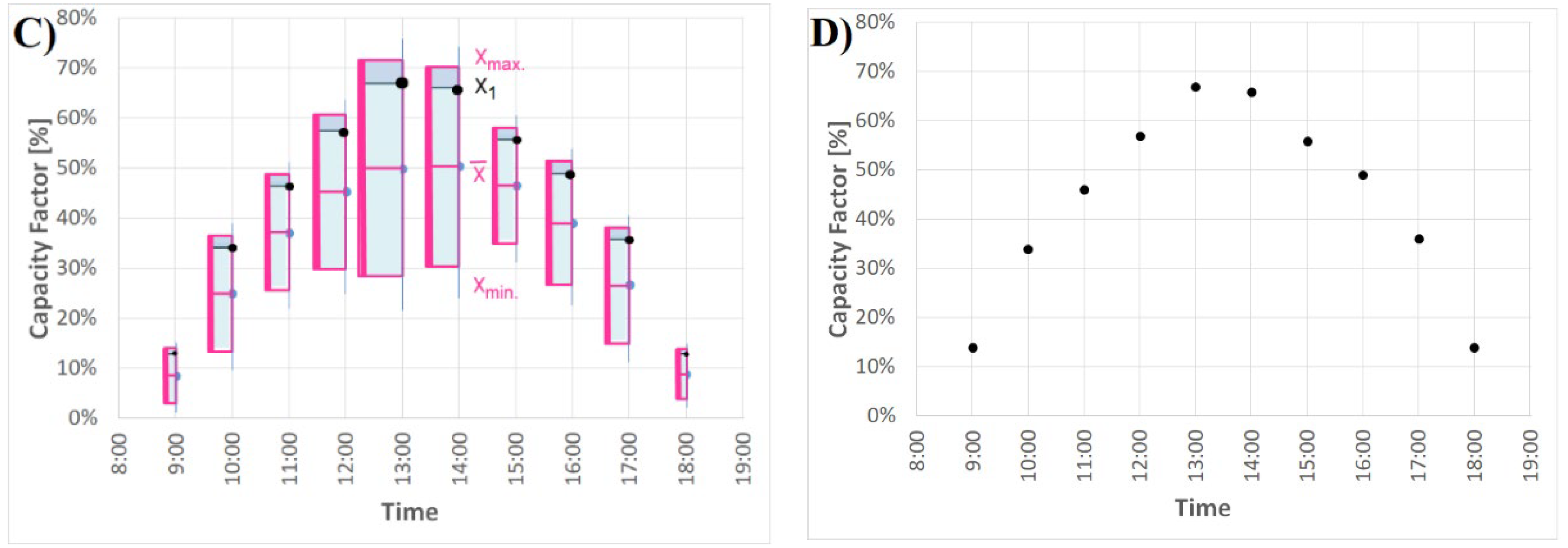
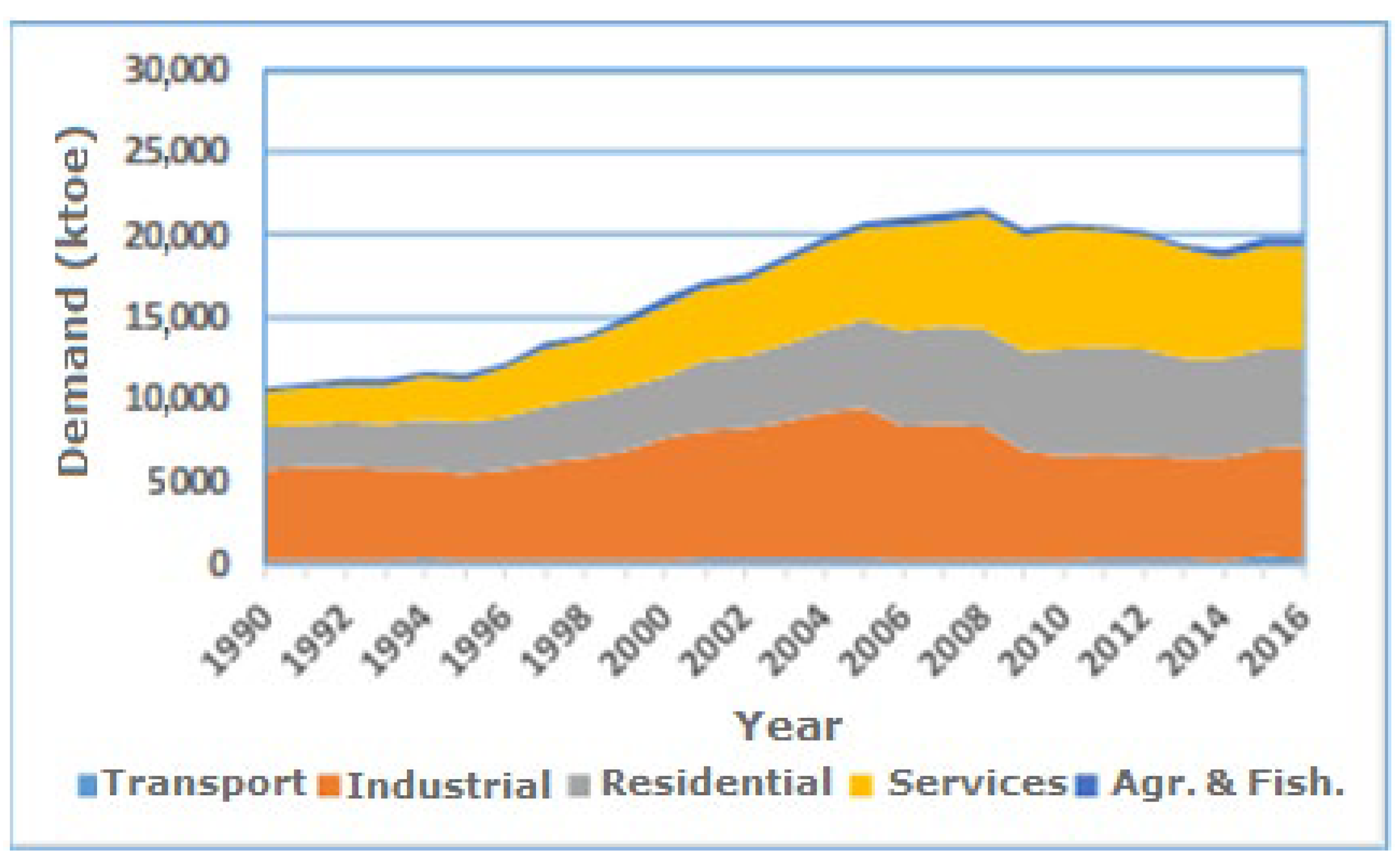

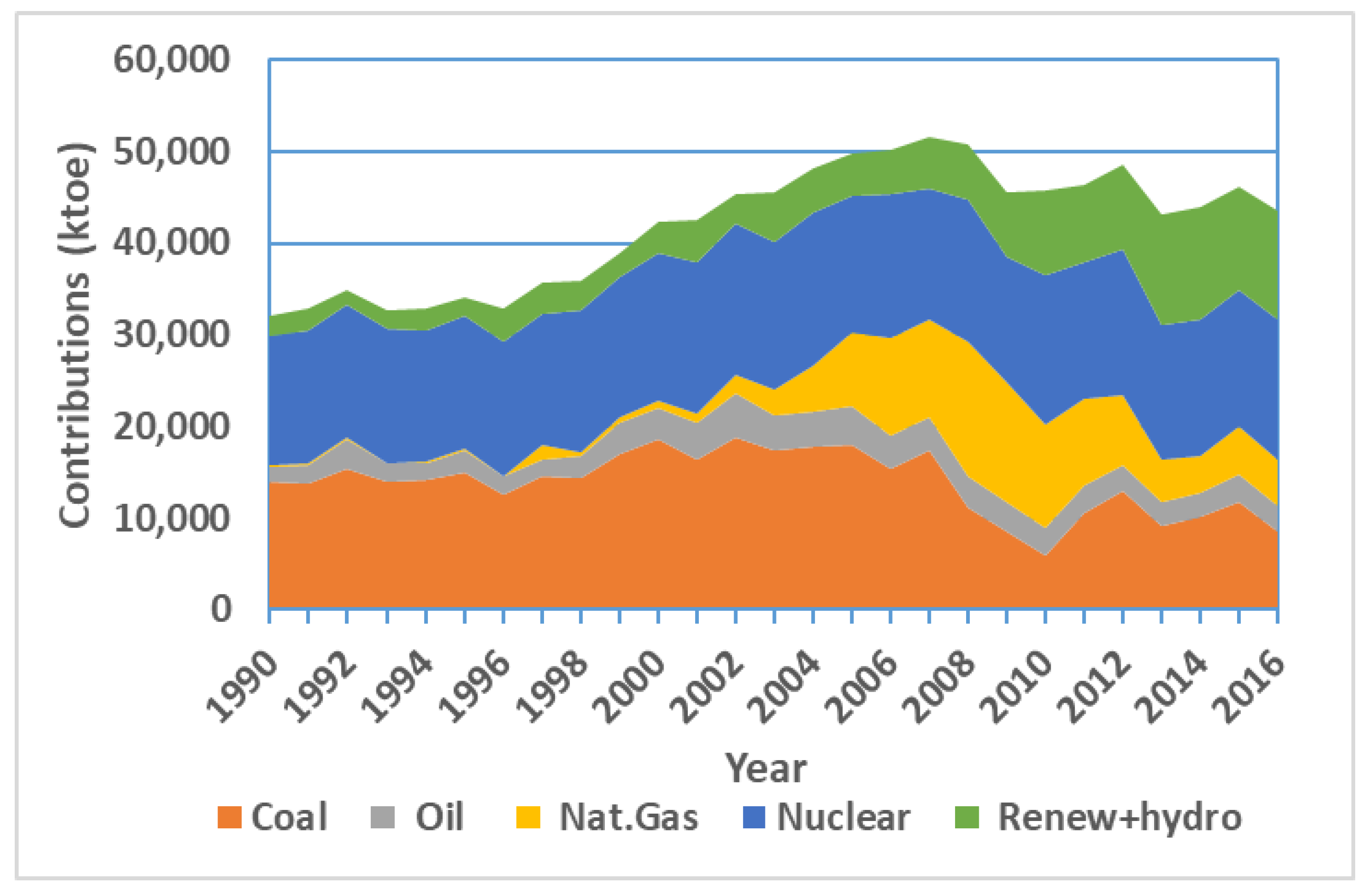
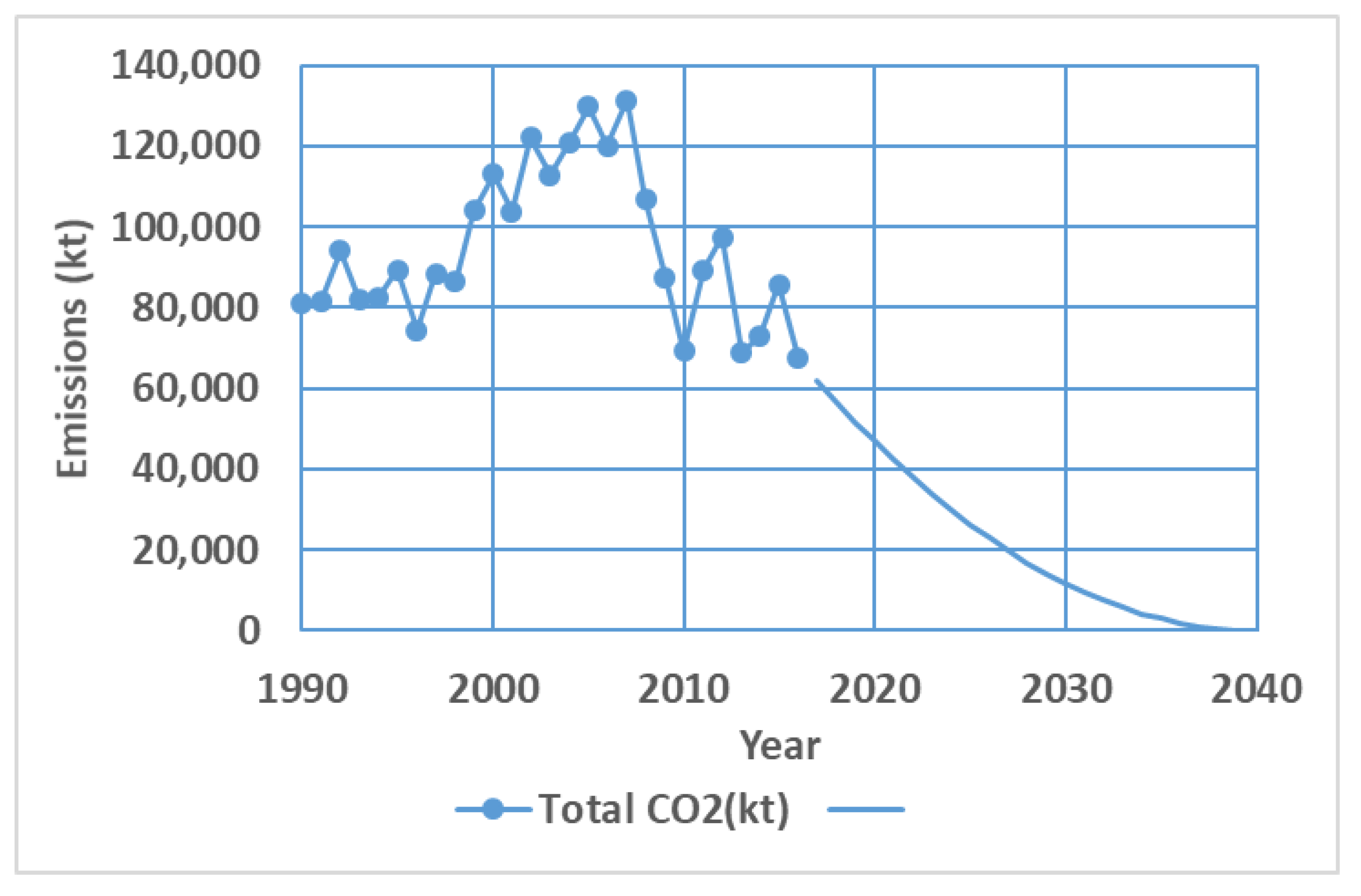
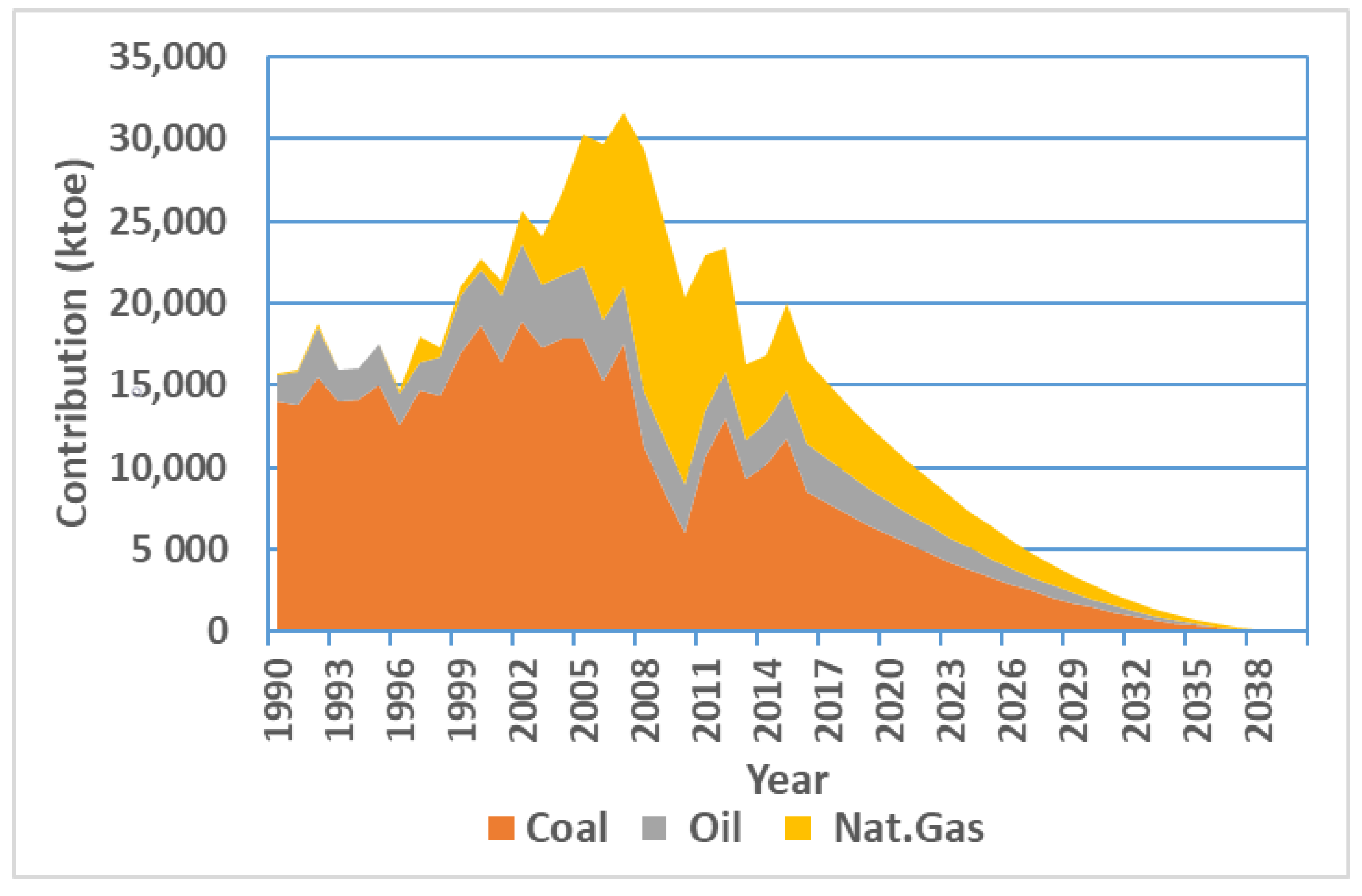
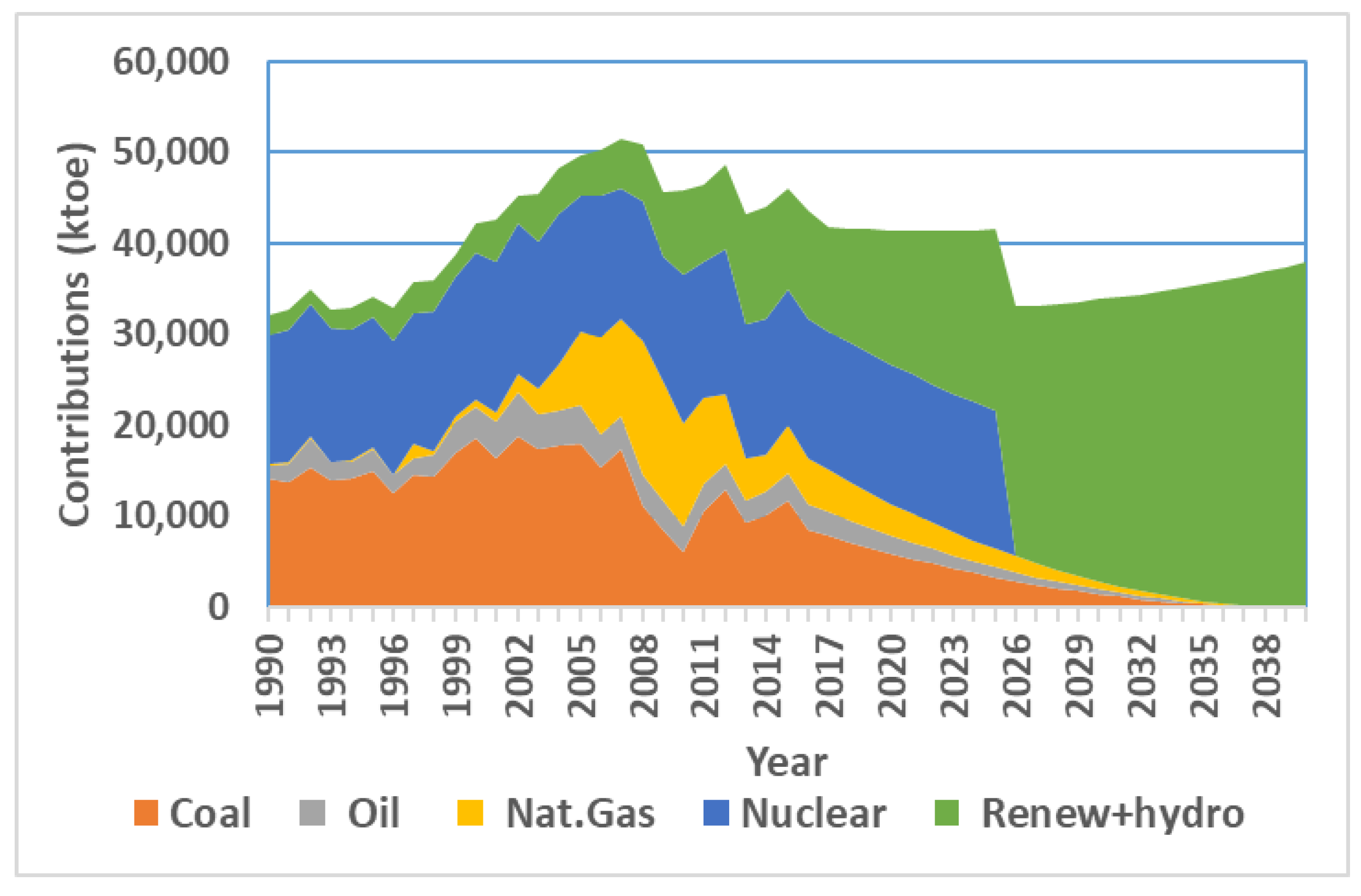
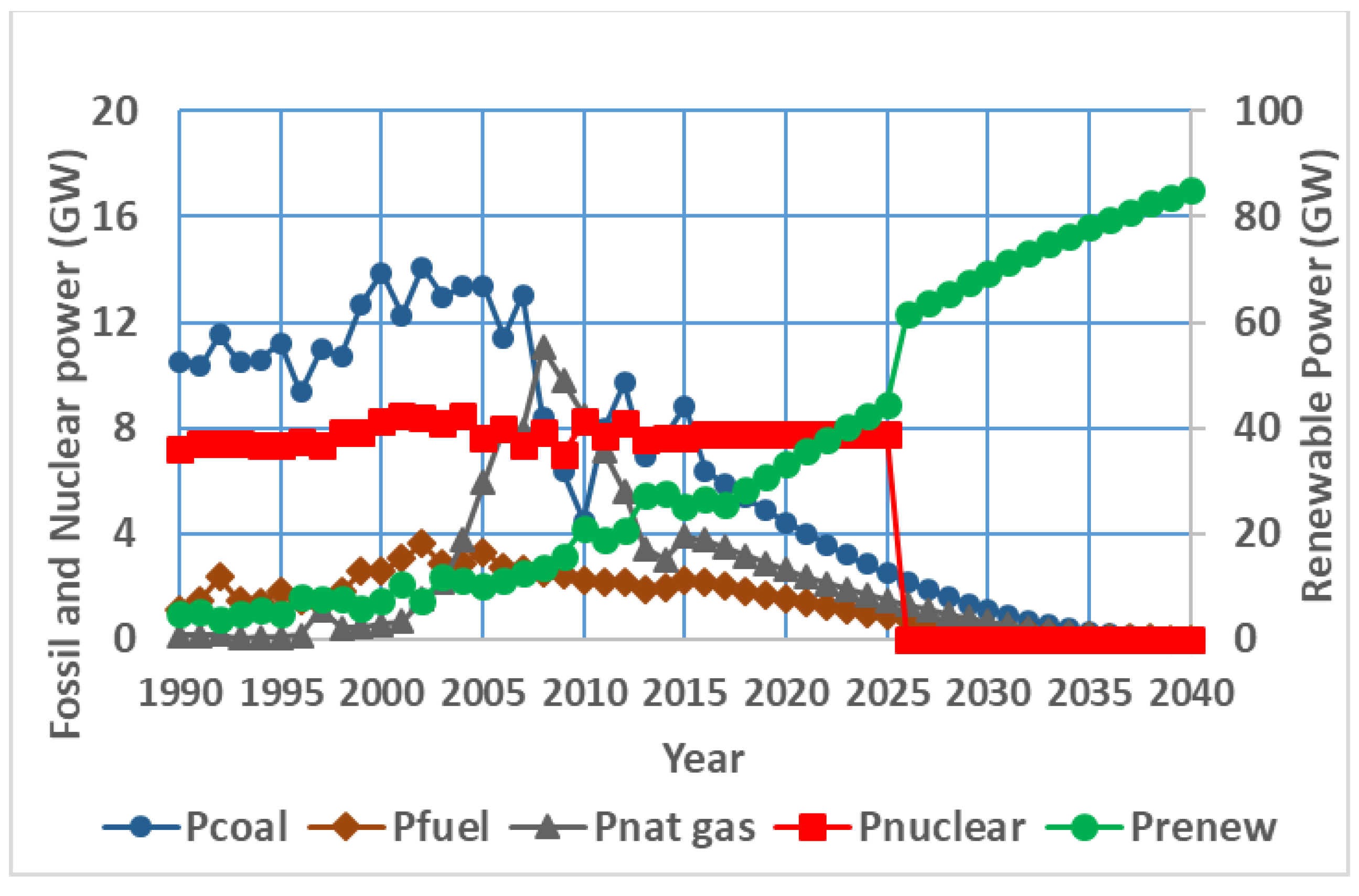
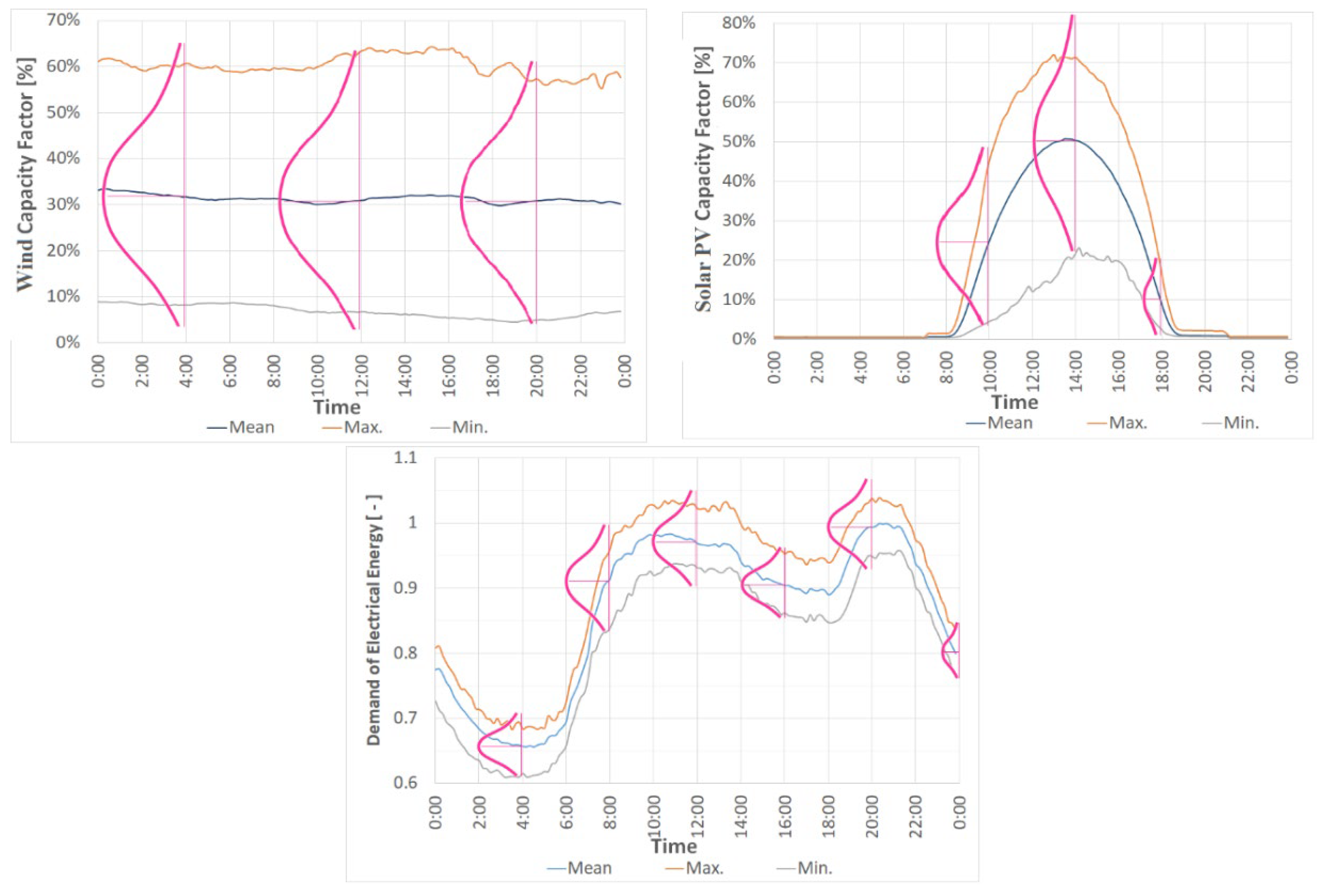


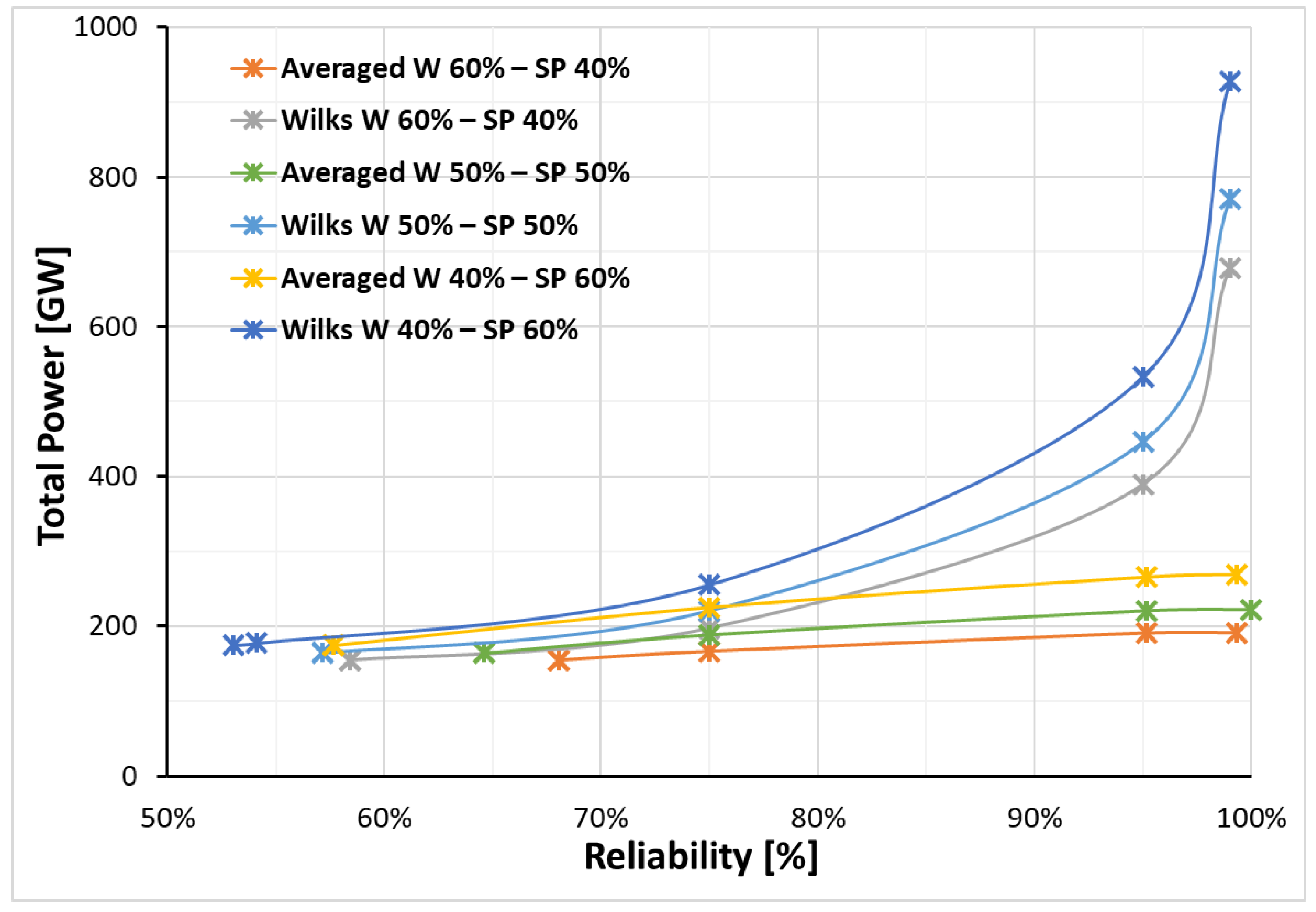
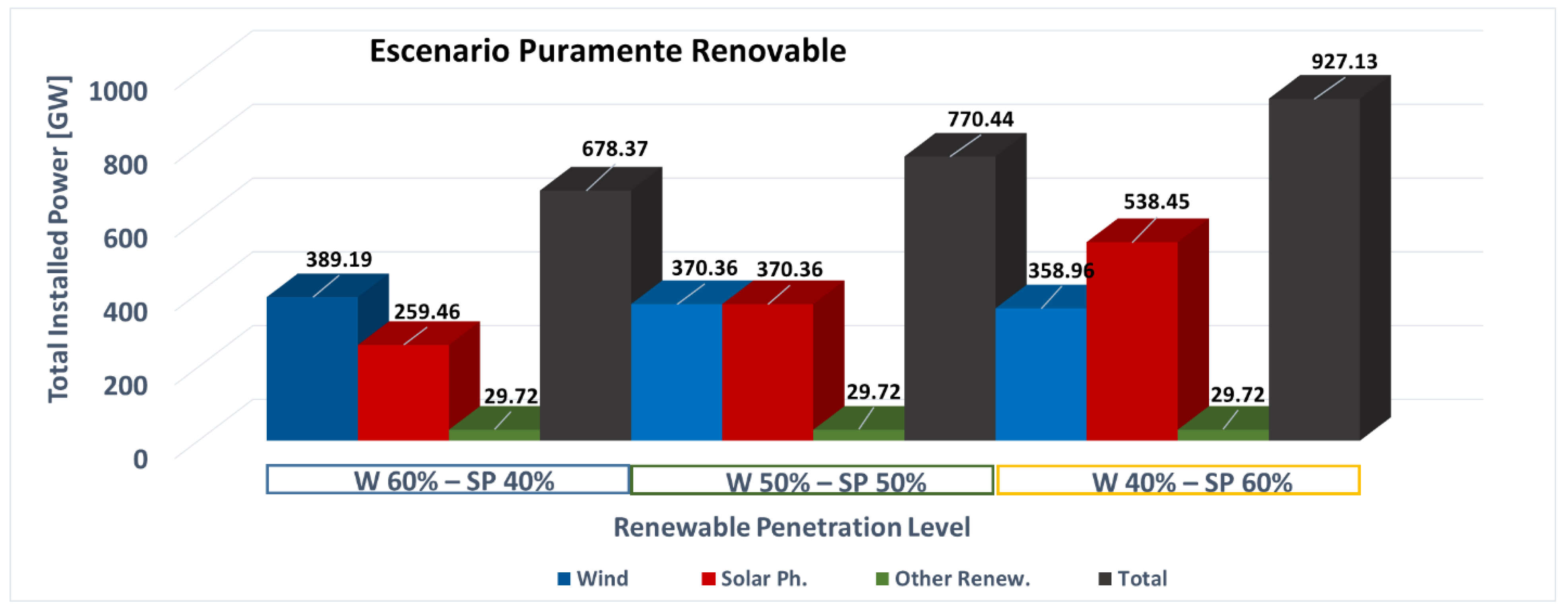
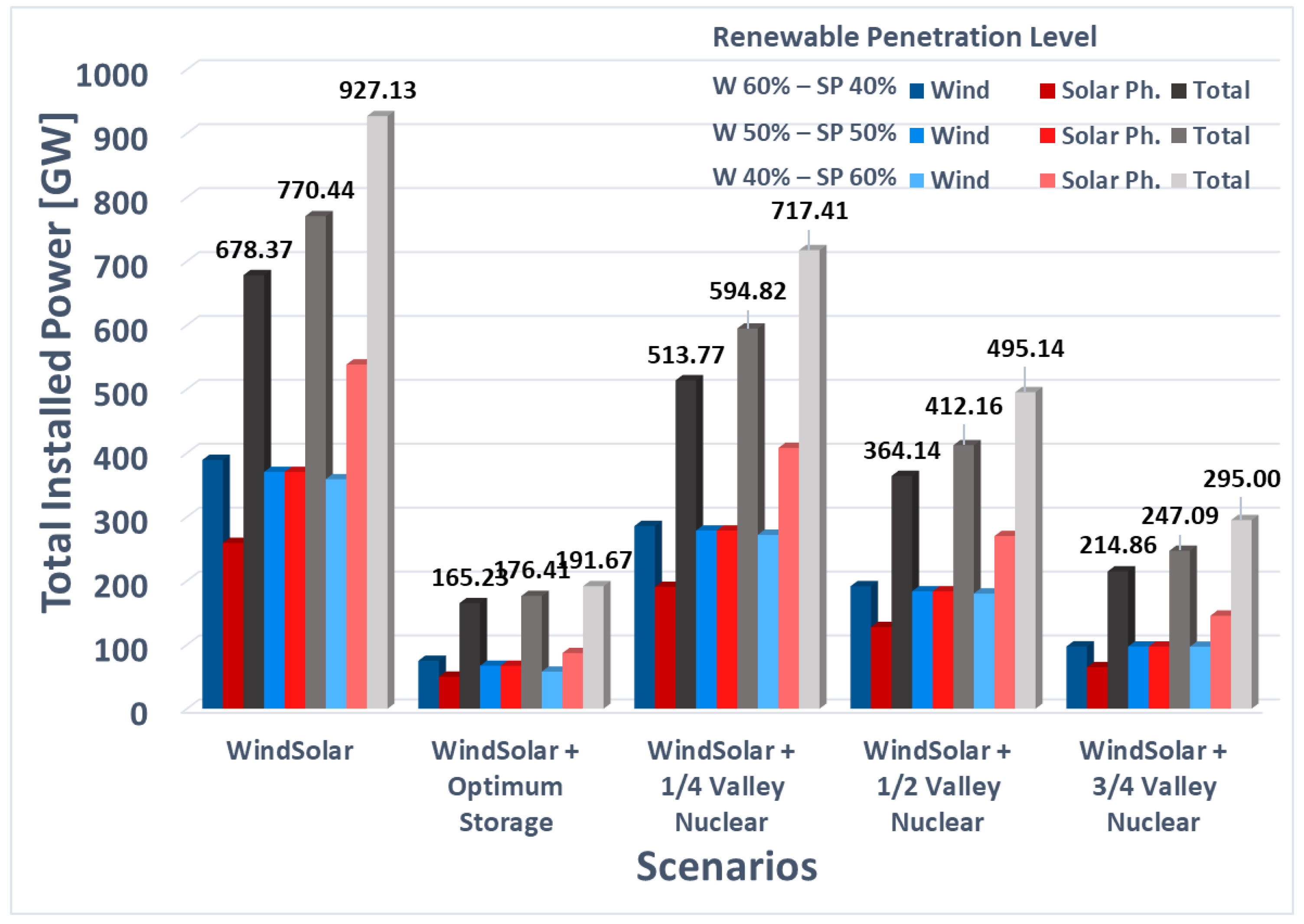
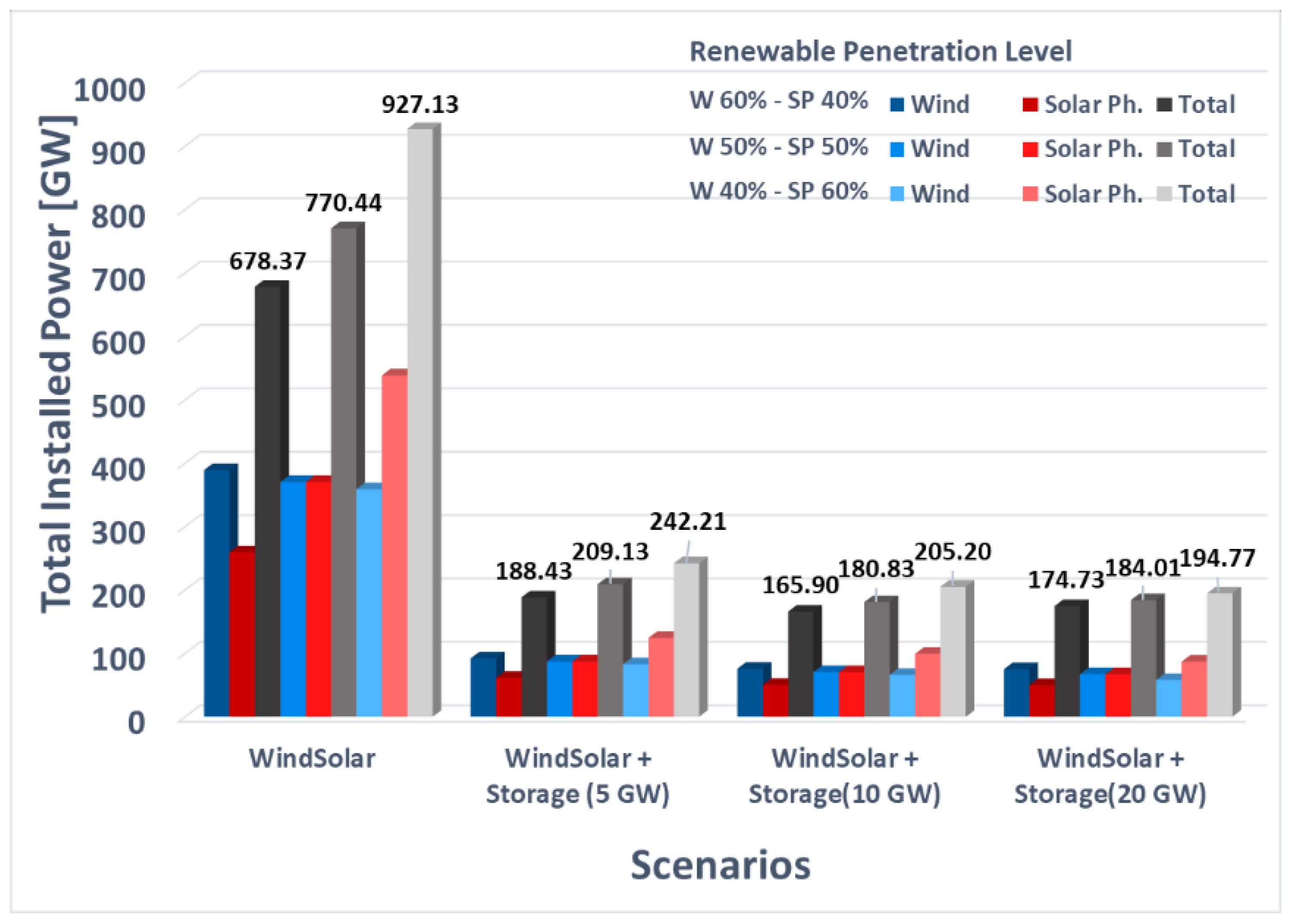
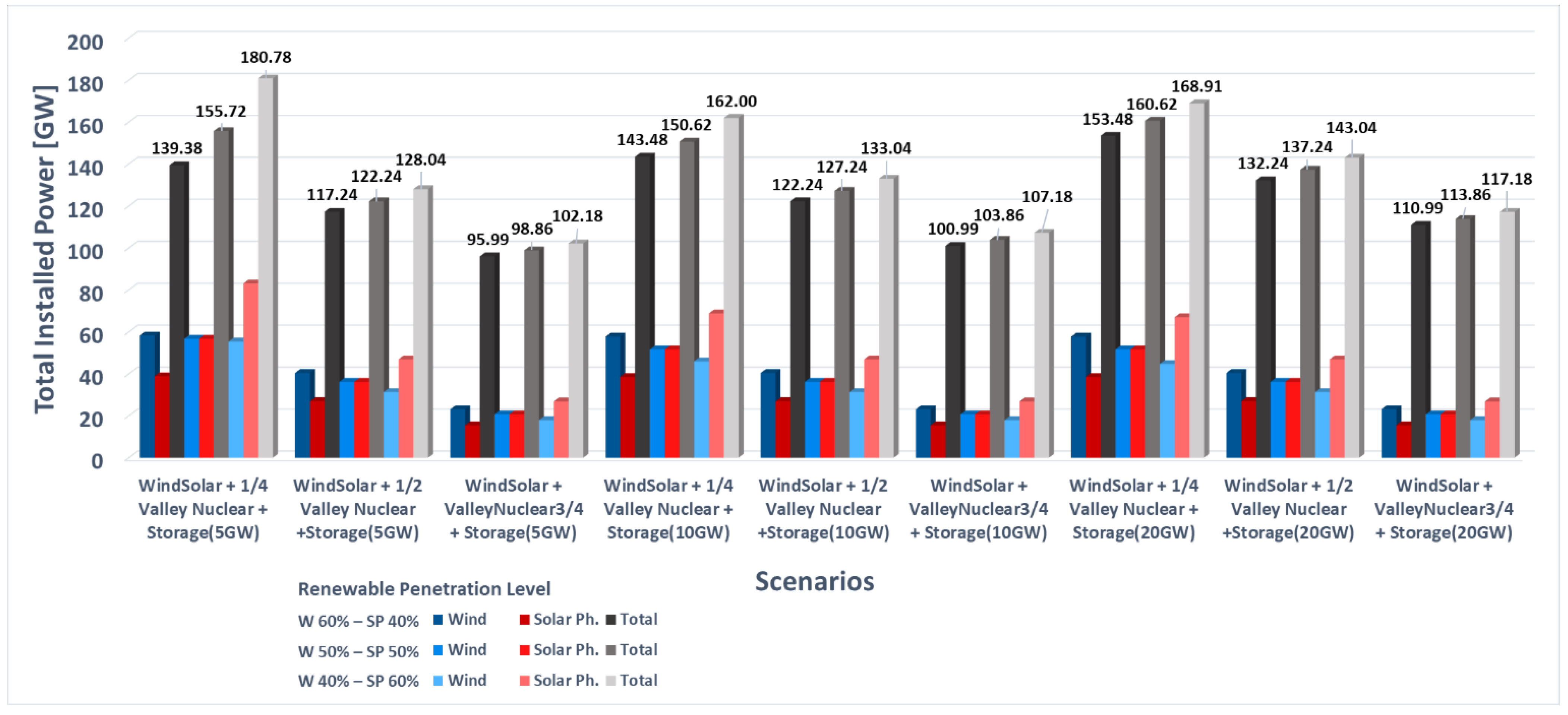
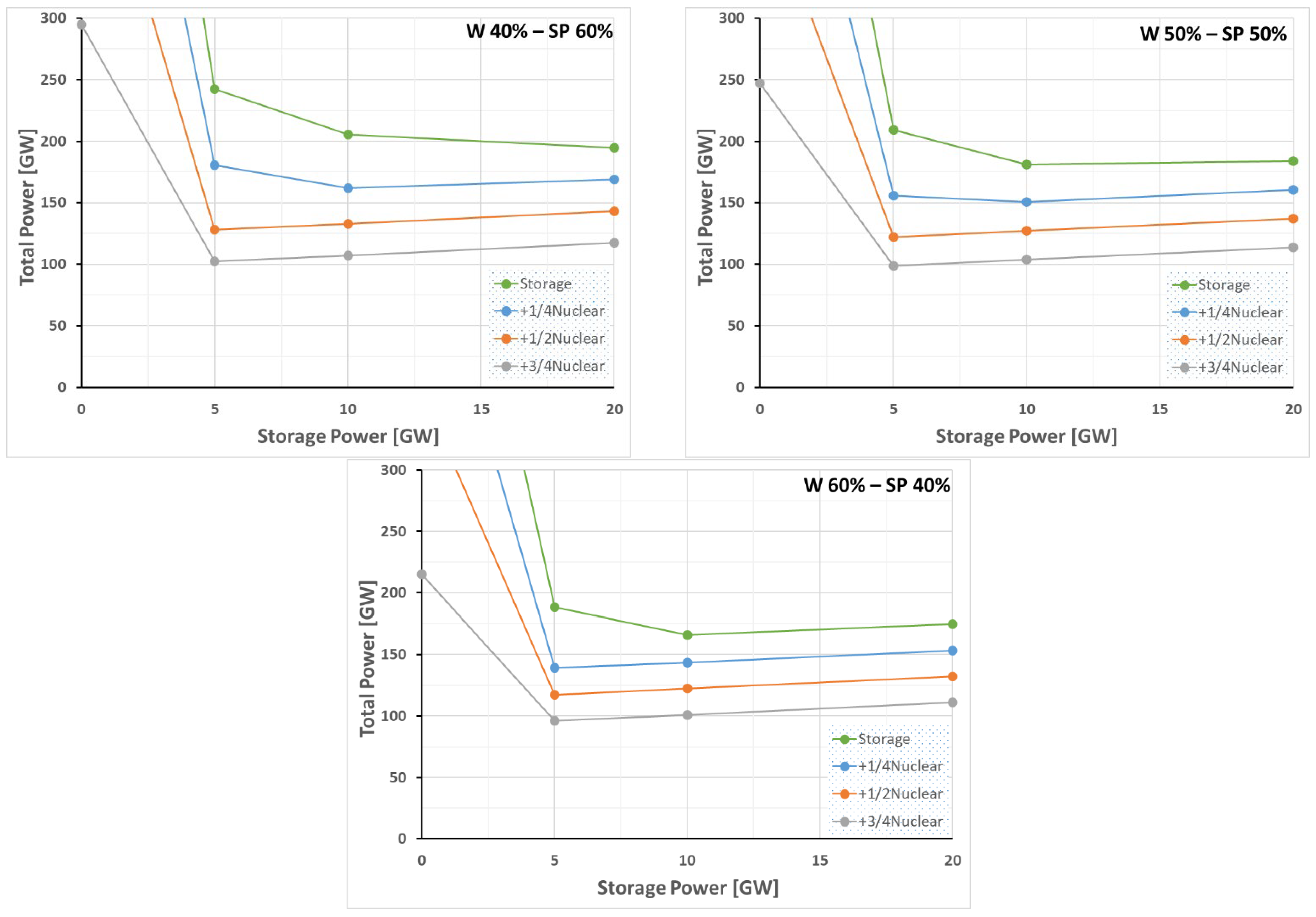
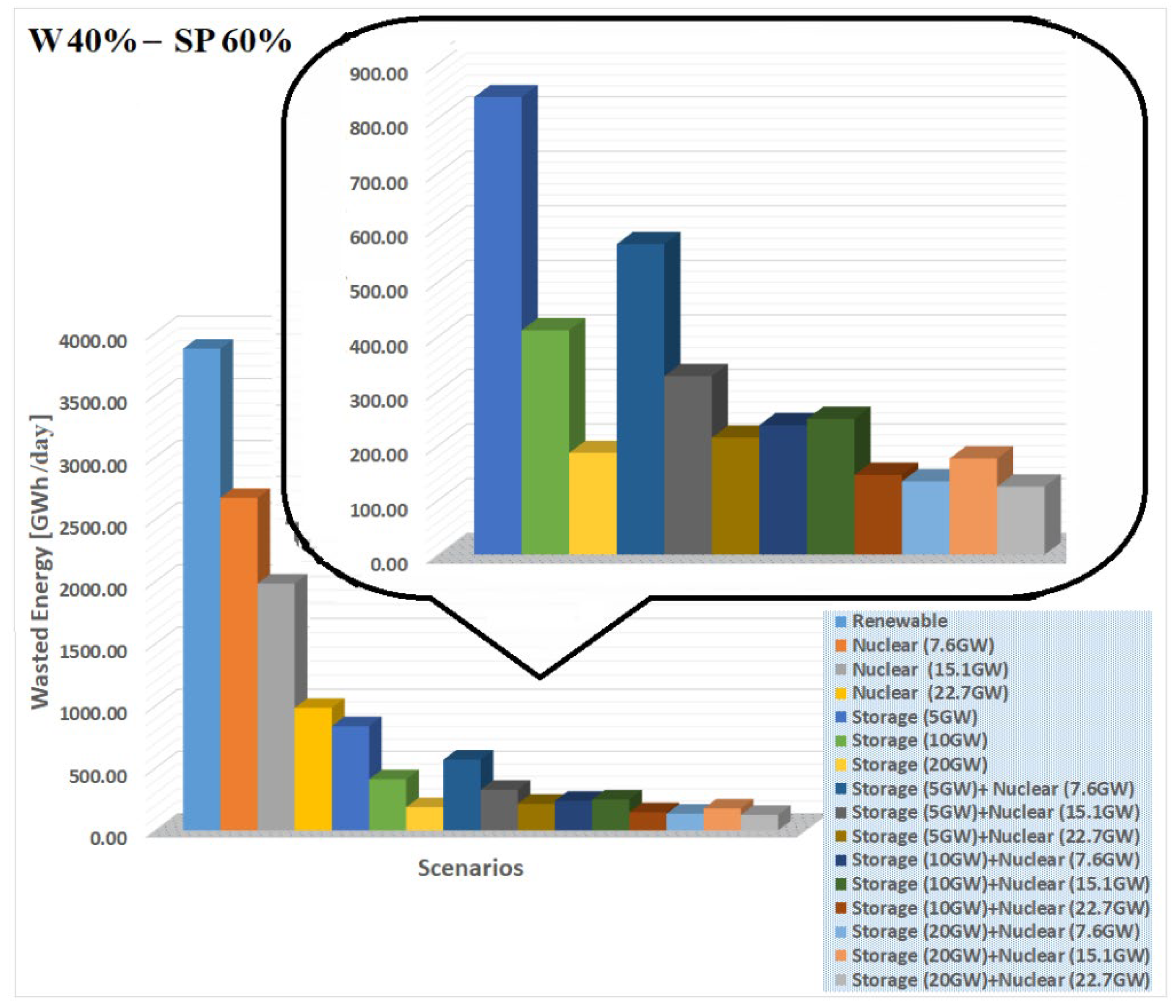


| Source | CO2 Emissivity (kt/ktoe) | CO2 Emissivity (g/kWh) |
|---|---|---|
| Coal | 5.4 | 464.43 |
| Oil | 3.2 | 275.15 |
| Natural gas | 2.4 | 206.36 |
| Primary Source | Generation Efficiency (%) | Annual Number of Operation Hours (h) |
|---|---|---|
| Coal | 40 | 6000 |
| Oil | 35 | 6000 |
| Natural gas | 60 | 6000 |
| Nuclear | 35 | 8500 |
| Renewable | 80 | 2200 |
| Variable | Parameters 1 | ||
|---|---|---|---|
| Mean | Standard Deviation | ||
| Wind | Normal | 0.3341 | 0.1577 |
| Solar Photovoltaic | Normal | 0.5083 | 0.1454 |
| Demand | Normal | 1 | 0.0236 |
| February 2017 | Year 2040 | |||
|---|---|---|---|---|
| Energy Source | Installed Power (GW) | Capacity Factor (CF) | Multiplier Factor (MF) | Installed Power (GW) |
| Hydraulic 1 | 16.9 | 0.215 | 1.1 | 18.6 |
| Cogeneration and Residuals | 6.54 | 0.554 | 1.5 | 9.81 |
| Rest of Renewables | 0.852 | 0.518 | 1.5 | 1.28 |
| Power (GW) for each Renewable Penetration Level (Wind-Solar Photovoltaic in %) | |||
|---|---|---|---|
| W 40%–SP 60% | W 50%–SP 50% | W 60%–SP 40% | |
| Monthly Averaged 1 | 174.8 | 164.0 | 154.7 |
| Daily Averaged | 268.6 | 222.4 | 191.1 |
| Monte-Carlo | 927.1 | 770.4 | 678.4 |
| Daily Wasted Energy (GWh) for Each Renewable Penetration Level (Wind-Solar Photovoltaic in %) | ||||
|---|---|---|---|---|
| W 40%–SP 60% | W 50%–SP 50% | W 60%–SP 40% | ||
| Pure Renewable | 3873 | 3425 | 3216 | |
| Plus Nuclear | Current Power | 2673 | 2597 | 2570 |
| Upgrading x 2 | 1985 | 1731 | 1609 | |
| Upgrading x 4 | 985 | 947 | 920 | |
| Plus Storage | Current Storage | 839 | 666 | 579 |
| Upgrading x 2 | 411 | 296 | 247 | |
| Upgrading x 4 | 186 | 175 | 173 | |
| Plus Nuclear and Storage | Current Values | 569 | 521 | 507 |
| Storage upgrading x 2 | 237 | 303 | 398 | |
| Storage upgrading x 4 | 134 | 209 | 286 | |
| Nuclear upgrading x 2 | 327 | 321 | 323 | |
| Plus Storage upgrading x 2 | 249 | 239 | 239 | |
| Plus Storage upgrading x 4 | 176 | 170 | 169 | |
| Nuclear upgrading x 3 | 214 | 264 | 311 | |
| Plus Storage upgrading x 2 | 146 | 184 | 221 | |
| Plus Storage upgrading x 4 | 125 | 151 | 174 | |
Publisher’s Note: MDPI stays neutral with regard to jurisdictional claims in published maps and institutional affiliations. |
© 2021 by the authors. Licensee MDPI, Basel, Switzerland. This article is an open access article distributed under the terms and conditions of the Creative Commons Attribution (CC BY) license (https://creativecommons.org/licenses/by/4.0/).
Share and Cite
Berna-Escriche, C.; Pérez-Navarro, Á.; Escrivá, A.; Hurtado, E.; Muñoz-Cobo, J.L.; Moros, M.C. Methodology and Application of Statistical Techniques to Evaluate the Reliability of Electrical Systems Based on the Use of High Variability Generation Sources. Sustainability 2021, 13, 10098. https://doi.org/10.3390/su131810098
Berna-Escriche C, Pérez-Navarro Á, Escrivá A, Hurtado E, Muñoz-Cobo JL, Moros MC. Methodology and Application of Statistical Techniques to Evaluate the Reliability of Electrical Systems Based on the Use of High Variability Generation Sources. Sustainability. 2021; 13(18):10098. https://doi.org/10.3390/su131810098
Chicago/Turabian StyleBerna-Escriche, César, Ángel Pérez-Navarro, Alberto Escrivá, Elías Hurtado, José Luis Muñoz-Cobo, and María Cristina Moros. 2021. "Methodology and Application of Statistical Techniques to Evaluate the Reliability of Electrical Systems Based on the Use of High Variability Generation Sources" Sustainability 13, no. 18: 10098. https://doi.org/10.3390/su131810098
APA StyleBerna-Escriche, C., Pérez-Navarro, Á., Escrivá, A., Hurtado, E., Muñoz-Cobo, J. L., & Moros, M. C. (2021). Methodology and Application of Statistical Techniques to Evaluate the Reliability of Electrical Systems Based on the Use of High Variability Generation Sources. Sustainability, 13(18), 10098. https://doi.org/10.3390/su131810098








